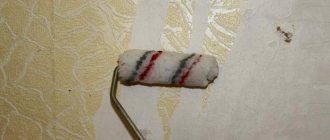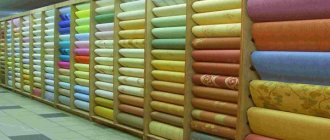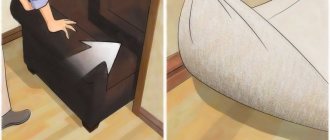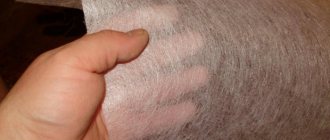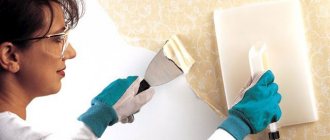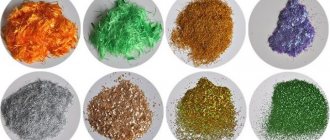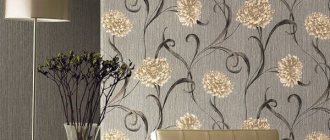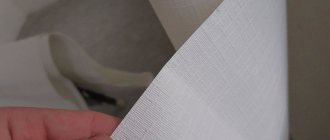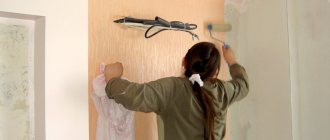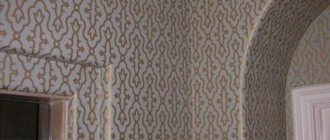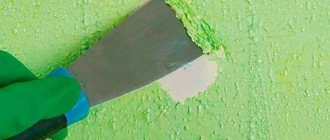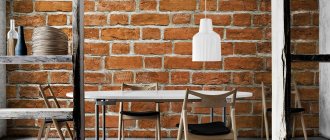If there is wallpaper in the room, it will have to be removed before renovation. And if you know how to remove vinyl wallpaper from walls correctly, this task will be simple and quick.
There are several universal methods that can be used to remove vinyl, paper and non-woven wallpaper from walls.
Preparation
Before you start removing wallpaper, it is advisable to prepare your tools and room.
What you will need:
- ladder;
- metal spatula;
- knife, metal brush;
- roller with spikes;
- film, masking tape;
- sprayer, bucket;
- rags, sponge;
- individual protection means;
- for severe cases - a grinder or drill with a special brush attachment.
When all the tools are ready, it is advisable to prepare the room.
To do this you need:
- Remove or cover all furniture with plastic.
- Since the walls will have to be wetted, you need to spread a film under them and glue its edges with masking tape. This way, water will not get on the floor.
- Cover sockets and switches with tape.
- Before starting work, it is better to turn off the electricity in the room.
You only need to use masking tape - it peels off easily and leaves no traces behind.
Preparatory work
Before you remove the wallpaper, you need to prepare the room. To free up space for work, move furniture to another room. Cover remaining items with old sheets or plastic wrap. To protect the floor, cover it with oilcloth or thick paper. To prevent trash from spreading around the apartment, place a damp cloth on the threshold.
When using the wet method of removing vinyl wallpaper on non-woven or paper backing, de-energize the room. This will avoid short circuit. To prevent moisture from getting into sockets and switches, seal them with tape or polyethylene.
Prepare all the necessary tools that you will need to remove the wallpaper:
- A roller equipped with spikes (“wallpaper tiger”). The tool perforates the wallpaper, which will speed up the penetration of water or solution to the glue.
- Spatulas of different widths, metal scrapers and knives.
- Foam roller and soft sponges, as well as old rags.
- Stepladder or stools.
- Water container.
- Rubber gloves for hands.
- Large trash bags.
What you need to know
- Vinyl wallpaper can be paper or non-woven based, but the technology for removing it from the walls will be the same.
- The vinyl layer will be saturated with water for a long time, so you have to wet the wall several times.
- You should not wet the wall completely - it is better to apply water to 2-3 panels. While one is removed, the other will have time to soak. If you wet the entire wall, the outer panels will dry before they get to the point.
- The water should be hot - cold water takes longer to penetrate the base. To make the old glue dissolve better, add regular detergent to the water.
- If the old wallpaper is washable, add the simplest wallpaper glue to the water. If you apply such a solution to the wall, it will not drain and after 10-20 minutes the canvas will be ready for removal. You can also use special products to remove old wallpaper.
- Vinyl is a durable material, so the canvas can be removed from the wall entirely, and not in pieces. Naturally, you need to completely wet it and wait until the glue gets wet.
How to remove vinyl wallpaper from walls
Method I
Stage 1 - perforation
If simple paper wallpapers can be simply wetted in order to be removed, then with vinyl wallpapers it is more difficult. The fact is that vinyl wallpaper for walls has a durable moisture-resistant coating and it will not be easy to wet it with water. This will take a lot of time and effort. Therefore, first of all, you need to break the vinyl top layer so that water can easily penetrate under the wallpaper and dissolve the adhesive layer. To do this you will need a spiked roller or wallpaper tiger. They can easily perforate wallpaper without damaging the wall surface.
Stage 2 – moisturizing
You can simply moisten the wallpaper with warm water or water with the addition of a special liquid, which will quickly saturate the wallpaper and dissolve the layer of glue. Such special means do not pose a threat to human health and can be used indoors. Apply water with a roller, a regular sponge or using a spray bottle.
Stage 3 – removal
Vinyl wallpaper begins to be removed from the wall only when it is well saturated with moisture. However, do not overdo it with the amount of water so as not to damage the floor surface and not to wet the wall too much. Subsequent work can only be carried out after the walls are dry. Remove the wallpaper from bottom to top, removing remaining pieces with a spatula. Moisten islands that are difficult to remove with water again and clean with a spatula. For work, choose a wide wooden or metal spatula.
Method II
There is another way: To do this, you will need a steam generator or an iron with steaming capability. After destroying the front side of the wallpaper, treat it with steam and after a while remove it with a spatula. The principle of operation is that wallpaper glue swells under the influence of steam and is easily removed from the wall. In addition, without water there is less dirt.
Method III
For difficult cases, when the wallpaper is difficult to remove, add a little wallpaper glue to the water with a special wallpaper remover. Cover the wall with the resulting mixture and leave for 2-3 hours. After this, the wallpaper is removed in solid strips without breaks. There is no need to scrape them off piece by piece.
Some advise using regular detergents instead of a special liquid. This should not be done, as it can ruin the layer of putty or plaster. In addition, there is a risk that a layer of powder will remain on the surface of the walls and may deteriorate the properties of the adhesive when it comes into contact with the wall.
If you leave the wallpaper on the wall
In old apartments, a situation often occurs when several layers of paper wallpaper are pasted on the walls. Usually this is a relic of Soviet times - then it was much easier to leave the old paper wallpaper and stick new ones on top. Why is that?
Firstly, the paper is not durable - it tears easily, so the canvas has to be removed in small pieces. And this is long, tedious and difficult. Secondly, Soviet glue was durable and moisture-resistant - but this did not make the work easier. On the other hand, the wallpaper adhered well to the walls, so it served as a strong basis for new ones.
Now the situation is different. Modern apartments use vinyl, non-woven and washable wallpaper. Yes, and the glue used is different. Therefore, they need to be completely removed from the walls.
Why do this:
- If wallpaper is glued end to end, it needs a flat surface.
- Modern wallpaper glue is water-soluble, so it can absorb moisture during pasting and begin to bubble.
- It is not a fact that the old canvas is well glued to the wall. In some places it may come off the wall along with the new one.
- Cavities may form between the layers of wallpaper and mold will quickly grow in them.
Therefore, it is better to clean the wall, especially since there are special tools and methods for this.
Removing Vinyl Wallpaper
Removing vinyl wallpaper from walls is quite easy. Since vinyl forms a durable film, the canvas is completely separated from the wall. In addition, they are two-layer.
Therefore, you can try to tear off the top layer of vinyl from the paper base, and then soak the remnants of the bottom layer with water and clean them off with a spatula. But it is not always possible to do this.
It is recommended to use the following sequence:
- If the wallpaper is washable, scratch the top layer with a spiked roller or knife. The main thing is not to overdo it, so as not to make grooves on the wall. For a non-woven base, the cuts need to be made wider and deeper than for a paper base.
- Moisten the cloth with warm water. This can be done with a sprayer, a roller or a sponge - there is no difference.
- You need to wait 15-20 minutes until the canvas is well soaked. It is possible that you will have to wet it several times.
- As soon as the water has dissolved the glue, you can remove the canvas. To do this, an incision is made in the upper part of the wall and the canvas is pulled down. At the same time, it is better not to rush and not to pull too hard - otherwise it will begin to tear.
- As a result, the canvas is separated from the wall almost entirely - small sections of the base remain.
- The remaining pieces are cleaned from the wall with a brush or spatula.
This is a universal method; it can be used to remove non-woven and any washable wallpaper.
Vinyl wallpaper: technical specifications
This is a two-layer material, the top layer is vinyl, polyvinyl chloride to be precise. And the bottom layer is either non-woven or paper. Naturally, the paper base will not be as durable as the non-woven one, and for many when choosing wallpaper this is of decisive importance.
Vinyl wallpaper can have a paper backing or non-woven backing
The appearance and maintenance features depend on both the type of vinyl and its finish.
You can buy paintable vinyl wallpaper, which is a base material with a certain relief, which you can transform yourself by choosing the right paint.
This coating is quite heavy, so regular cheap wallpaper glue will not work - you need special glue for vinyl wallpaper. Only the wall is smeared; there is no need to apply glue to the canvas.
Types and characteristics of vinyl wallpaper (video review)
Using steam
If you have a steam generator, removing old wallpaper will be as easy as shelling pears. Under the influence of temperature, the glue softens and the canvas is easily removed from the wall.
But not everyone has such a device. But everyone has an iron. If it does not have a vertical steam function, this is not a problem. You can take a damp cloth and iron a section of the wall through it. The effect will be almost the same as from a steam generator. This method is good for removing washable wallpaper.
Severe cases
If old wallpaper is glued to the wall with water-insoluble glue, such as PVA, it will be much more difficult to remove it. Wetting with water will not help here; more radical measures are required.
You can peel them off with a spatula. You must first treat the surface with a special solution for removing wallpaper. They won't be able to completely dissolve the glue, but it will make the job easier.
Another option is to use a sander or drill. To do this you will need a special metal brush attachment. Typically, metal surfaces are cleaned of rust in this way.
If using an angle grinder:
- The brush should be of medium hardness. A soft nozzle will take a long time to clean, but a hard one will damage the wall.
- Carrying required.
- It will be dusty - you need to wet the wall first.
- Be sure to wear safety glasses or a mask. Metal hairs can fly off the brush and even pierce clothing. If such a thing gets in the face, there will be an injury.
If the wall is made of plasterboard
Drywall is a fragile material and it is afraid of moisture. This will have to be taken into account when removing old wallpaper:
- The wall becomes moisturized gradually, even if the slab is moisture resistant.
- Do not make deep cuts - drywall can be easily damaged.
- If wallpaper is pasted on a non-woven basis, you can simply peel it off and use the non-woven layer as a backing for a new coating.
- If the base is paper, it is better to use a special composition for removing wallpaper. The top layer of drywall is also paper, and the two layers of paper stick together very well. Therefore, removing such a base without damaging the slab will not be easy.
If the wallpaper is glued to the drywall with water-insoluble glue, it will not be possible to remove it without damaging the sheet. It is more advisable to immediately change the entire slab.
In most cases, removing old vinyl wallpaper from walls is not difficult. Sometimes, of course, complications arise, but they can be dealt with without any problems.
It is important to understand that almost all vinyl wallpaper is washable - so you need to wait until the canvas is saturated with water and the glue gets wet. If you don't rush, the canvas will be removed easily and simply.
We use steam
This option has to be activated from the arsenal in cases where neither the dry nor the wet method described above helped remove wallpaper from the walls quickly. But at home we always use an iron, and this is where its steaming function comes in handy.
- separate from the wall those fragments that can easily be removed even with an ordinary spatula;
- take a sheet and put it in a bucket of water;
- squeeze it well and apply it to the wall in those areas that were torn;
- turn on the iron to maximum temperature and run it over the sheet several times;
- remove the steamed fragments.
Instead of an iron, you can use a regular household steam cleaner
. In this case, you can use a dry sheet. It is very important that the sheet covers as much area as possible, so take your wife, son, daughter, friend or, at worst, a neighbor as your partner - this will increase the efficiency of the operation significantly!
